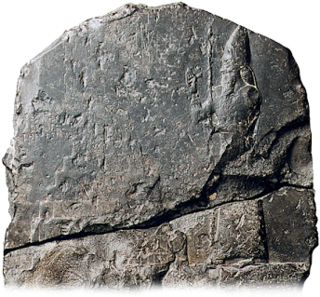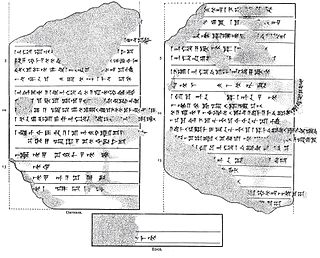
Chaldea was a small country that existed between the late 10th or early 9th and mid-6th centuries BC, after which the country and its people were absorbed and assimilated into the indigenous population of Babylonia. Semitic-speaking, it was located in the marshy land of the far southeastern corner of Mesopotamia and briefly came to rule Babylon. The Hebrew Bible uses the term כשדים (Kaśdim) and this is translated as Chaldaeans in the Greek Old Testament, although there is some dispute as to whether Kasdim in fact means Chaldean or refers to the south Mesopotamian Kaldu.

Babylonia was an ancient Akkadian-speaking state and cultural area based in the city of Babylon in central-southern Mesopotamia. It emerged as an Akkadian populated but Amorite-ruled state c. 1894 BC. During the reign of Hammurabi and afterwards, Babylonia was retrospectively called "the country of Akkad", a deliberate archaism in reference to the previous glory of the Akkadian Empire. It was often involved in rivalry with the older ethno-linguistically related state of Assyria in the north of Mesopotamia and Elam to the east in Ancient Iran. Babylonia briefly became the major power in the region after Hammurabi created a short-lived empire, succeeding the earlier Akkadian Empire, Third Dynasty of Ur, and Old Assyrian Empire. The Babylonian Empire rapidly fell apart after the death of Hammurabi and reverted to a small kingdom centered around the city of Babylon.

Nebuchadnezzar II, also spelled Nebuchadrezzar II, was the second Neo-Babylonian emperor, ruling from the death of his father Nabopolassar in 605 BC to his own death in 562 BC. Historically known as Nebuchadnezzar the Great, he is typically regarded as the empire's greatest king. Nebuchadnezzar remains famous for his military campaigns in the Levant, for his construction projects in his capital, Babylon, including the Hanging Gardens of Babylon, and for the role he plays in Jewish history. Ruling for 43 years, Nebuchadnezzar was the longest-reigning king of the Babylonian dynasty. By the time of his death, he was among the most powerful rulers in the world.

Nabonidus was the last king of the Neo-Babylonian Empire, ruling from 556 BC to the fall of Babylon to the Achaemenian Empire under Cyrus the Great in 539 BC. Nabonidus was the last native ruler of ancient Mesopotamia, the end of his reign marking the end of thousands of years of Sumero-Akkadian states, kingdoms and empires. He was also the last independent king of Babylon. Regarded as one of the most vibrant and individualistic rulers of his time, Nabonidus is characterised by some scholars as an unorthodox religious reformer and as the first archaeologist.

Marduk-apla-iddina I, contemporarily written in cuneiform as 𒀭𒀫𒌓𒌉𒍑𒋧𒈾dAMAR.UTU-IBILA-SUM-na and meaning in Akkadian: "Marduk has given an heir", was the 34th Kassite king of Babylon ca. 1171–1159 BC. He was the son and successor of Melišipak, from whom he had previously received lands, as recorded on a kudurru, and he reigned for 13 years. His reign is contemporary with the Late Bronze Age collapse. He is sometime referred to as Merodach-Baladan I.

Nebuchadnezzar I, reigned c. 1121–1100 BC, was the fourth king of the Second Dynasty of Isin and Fourth Dynasty of Babylon. He ruled for 22 years according to the Babylonian King List C, and was the most prominent monarch of this dynasty. He is best known for his victory over Elam and the recovery of the cultic idol of Marduk.
The Canon of Kings was a dated list of kings used by ancient astronomers as a convenient means to date astronomical phenomena, such as eclipses. For a period, the Canon was preserved by the astronomer Claudius Ptolemy, and is thus known sometimes as Ptolemy's Canon. It is one of the most important bases for our knowledge of ancient chronology.

The Chaldean dynasty, also known as the Neo-Babylonian dynasty and enumerated as Dynasty X of Babylon, was the ruling dynasty of the Neo-Babylonian Empire, ruling as kings of Babylon from the ascent of Nabopolassar in 626 BC to the fall of Babylon in 539 BC. The dynasty, as connected to Nabopolassar through descent, was deposed in 560 BC by the Aramean official Neriglissar, though he was connected to the Chaldean kings through marriage and his son and successor, Labashi-Marduk, might have reintroduced the bloodline to the throne. The final Neo-Babylonian king, Nabonidus, was genealogically unconnected to the previous kings, but might, like Neriglissar, also have been connected to the dynasty through marriage.

Marduk-nādin-aḫḫē, inscribed mdAMAR.UTU-na-din-MU, reigned c. 1095–1078 BC, was the sixth king of the Second Dynasty of Isin and the 4th Dynasty of Babylon. He is best known for his restoration of the Eganunmaḫ in Ur and the famines and droughts that accompanied his reign.

Nabû-mukin-zēri, inscribed mdAG-DU-NUMUN, also known as Mukin-zēri, was the king of Babylon 731–729 BC. The Ptolemaic Canon gives his name as Χινζηρος. His reign was brought to its eventual end by the capture of the stronghold of Šapia by the forces of the Assyrian king Tukultī-apil-Ešarra III. The chief of the Chaldean Amukanu tribe in southern Babylonia, he took advantage of the instability which attended the revolt against Nabû-nādin-zēri and deposed its leader, Nabû-šuma-ukîn II.
Nabû-nādin-zēri, inscribed m[dNa]bû-nādìn-zēri in the King List A, the only place his full name is given, and Na-di-nu or Na-din in the Chronicle on the Reigns from Nabû-Nasir to Šamaš-šuma-ukin known as Chronicle 1, was the king of Babylon, son and successor of Nabû-Nasir. The Ptolemaic Canon gives his name as Νάδιος or Νάβιος, similar to the Chronicle version of his name.

Marduk-šāpik-zēri, inscribed in cuneiform dAMAR.UTU-DUB-NUMUN or phonetically -ša-pi-ik-ze-ri, and meaning “Marduk (is) the outpourer of seed”, reigned c. 1077–1065 BC, was the 7th king of the 2nd dynasty of Isin and 4th dynasty of Babylon and he ruled for thirteen years. His relationship with his predecessor, Marduk-nādin-aḫḫē is uncertain. His reign overlapped that of the Assyrian king Aššur-bēl-kala and his immediate predecessor(s) as the Synchronistic King List places him alongside both Tukultī-apil-Ešarra and Aššur-bēl-kala.
Simbar-Šipak, or perhaps Simbar-Šiḫu, was a Babylonian king who reigned c. 1021–1004 BC.
Ninurta-nādin-šumi, inscribed mdMAŠ-na-din-MU or dNIN.IB-SUM-MU, “Ninurta (is) giver of progeny,” c. 1127–1122 BC, was the 3rd king of the 2nd dynasty of Isin and 4th dynasty of Babylon. He reigned for seven years, contemporaneously with Aššur-reš-iši, c. 1133 to 1115 BC, the Assyrian king with whom he clashed.
Marduk-zer-X was the 10th and penultimate king of the 2nd Dynasty of Isin, the 4th Dynasty of Babylon. The last part of his name is unknown, as the principal sources of information, the King List A and the Synchronistic King List are both damaged at this place in the sequence, hence the “x”. The reading of “zer” in his name by Poebel is almost as uncertain, as the character may be MU which would correspond to šuma or similar. His Assyrian contemporary was Aššur-nasir-apli I.
Erība-Marduk, inscribed mri-ba [dAMAR.UTU], was the king of Babylon, very speculatively ca. 769 – 761 BC. He was one of three Chaldaean tribal leaders to occupy the Babylonian throne during the course of the 8th century and would be looked back as the ancestor figure during future reigns of members of this group. A member of the Bīt-Yakin tribe, who was later to be given the title "re-establisher of the foundation(s) of the land," he was credited with restoring stability to the country after years of turmoil.

The Eclectic Chronicle, referred to in earlier literature as the New Babylonian Chronicle, is an ancient Mesopotamian account of the highlights of Babylonian history during the post-Kassite era prior to the 689 BC fall of the city of Babylon. It is an important source of historiography from the period of the early iron-age dark-age with few extant sources to support its telling of events.

The Sargonid dynasty was the final ruling dynasty of Assyria, ruling as kings of Assyria during the Neo-Assyrian Empire for just over a century from the ascent of Sargon II in 722 BC to the fall of Assyria in 609 BC. Although Assyria would ultimately fall during their rule, the Sargonid dynasty ruled the country during the apex of its power and Sargon II's three immediate successors Sennacherib, Esarhaddon and Ashurbanipal are generally regarded as three of the greatest Assyrian monarchs. Though the dynasty encompasses seven Assyrian kings, two vassal kings in Babylonia and numerous princes and princesses, the term Sargonids is sometimes used solely for Sennacherib, Esarhaddon and Ashurbanipal.











